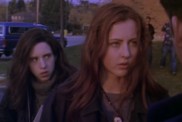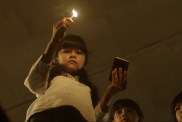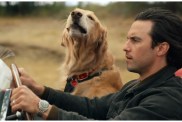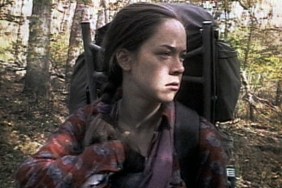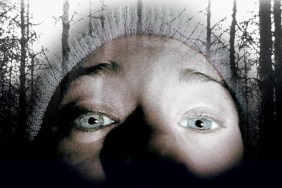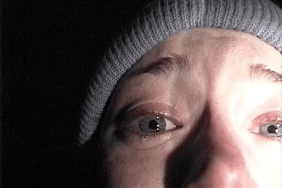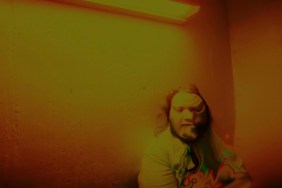Wingard and Barrett’s Blair Witch offers scares but plays it safe
Pity poor director Adam Wingard and his writer, Simon Barrett. The duo are the darlings of the contemporary American indie genre film world, with critically-lauded and fan-embraced movies like A Horrible Way to Die, You’re Next and The Guest under their belts. And yet they’ve opted to break that streak of original festival favorite filmmaking by taking on the task of helming the sequel (actually the third picture) in the Blair Witch franchise, a move that leaves them wide open for both intensified critical scrutiny and attacks from a dedicated, pre-existing fanbase.
So on that level, one must admire the pair. Presumably the paycheck was pretty and it’s clear that Wingard and Barrett have great affection for the groundbreaking first film, 1999’s The Blair Witch Project, but it took guts to put themselves out there and revisit, update and continue the lineage of a classic.
And with all that out of the way, we’ll cut right to the chase: Wingard and Barrett’s Blair Witch isn’t a bad movie, in fact it’s likely exactly what they – and Lionsgate – wanted it to be. But that’s also part of its problem. It feels totally safe. Love it or hate it, Joe Berlinger’s troubled first sequel, 2000’s Book of Shadows: Blair Witch 2 was not safe. It was an unconventional, bold and self-referential horror film that used the original found footage landmark as its springboard, playing more like a genre-fied exploration of the themes Berlinger and partner Bruce Sinofsky explored in their award-winning Paradise Lost documentaries. If it was a failure (and commercially and critically, it most certainly was), it was a bold failure and it stood alone.
Blair Witch, however, does not want to stand alone. It continues where the first picture left off – albeit years later – with the brother of the original’s final victim opting to allow his girlfriend to mount a documentary about his grief and quest for the truth and – you guessed it – head back to the woods. They take a few friends with them and, along with a pair of locals, proceed to embark on what they figure will ultimately be a bit of a lark. It’s certainly not a spoiler to say that all Hell breaks loose. Again. And that characters run around with cameras screaming and crying and dying. Again. What makes this round of dumb-kids-in-the-haunted-forest phony doc shenanigans different is technology. In the original, our heroes had a camera. We saw raw footage of that camera purporting to document their madness. It was urgent, alien and a bit dangerous. But here, Wingard and Barrett spend much time with our heroes arming themselves with state-of-the-art gadgets, cameras that mount to ears, heads and other parts of their persons. They even have a drone for those necessary aerial shots. As they identify their gear piece by piece, it feels like a bizarre parody of Q, the weapons guru in the James Bond flicks, larding up 007 with all manner of impossibly-designed devices. Perhaps that’s the point, and if it is, we’re sorry we missed it. But really, it just reeks of a new generation of tech-fetishists, one that often forgets the art of filmmaking and instead spends its time drooling over the latest image-capturing toys.

But a great camera can’t make a great movie and, despite having multiple POV angles to choose from, the end result is the same, just more sterile. People still run and yell and run and yell some more. There’s more gore this time around too, with characters getting bent in half and pulling trees out of infected limbs. There’s also a wealth of sound-jacked jump scares, the kind that the post The Conjuring-crowd seems to love so much. But these more explicit additions really just further exemplify how powerful the original was using so very little.
And on that note, if we are to suspend our disbelief… who cut this thing? Who did the post sound mix? The opening credits of the film state – like the original – that this footage was found in the woods. And yet the film is totally over-produced. The lines between real and fabricated aren’t blurred this time around, they’re cut completely clear.
Now, all that griping aside, there are still some good things in Blair Witch. The final 20 minutes is grueling; a surreal and claustrophobic smack down with characters running in a cursed cabin and all manner of phantasmagoria popping up to plague them. It’s scary. And there’s also a novel idea here that the Blair Witch has the power to bend time and space, with some characters claiming they’ve wandered the woods for days while other feeling the passing of mere hours. Shame they didn’t explore that more because it’s an effectively-upsetting concept.
Ultimately though, Blair Witch’s biggest problem is that the thrill is kinda gone. There’s no more novelty with this kind of movie. It’s not just a sequel to one of the most notorious horror hits of the past 20 years, it’s an imitation of the many imitations that followed. It’s a well-made found footage horror movie attached to a well-known brand. We didn’t hate it. Didn’t love it. Didn’t feel much of anything. It will make lots of money, though and there’s no doubt Lionsgate wants it to continue the franchise that Book of Shadows all but obliterated. So expect many more Blair Witch adventures to come. Hopefully the next one tries to break a few more rules.
Blair Witch
-
Blair Witch

-
Blair Witch

-
Blair Witch

-
Blair Witch

-
Blair Witch

-
Blair Witch

-
Blair Witch

-
Blair Witch

-
Blair Witch

-
Blair Witch

-
Blair Witch

